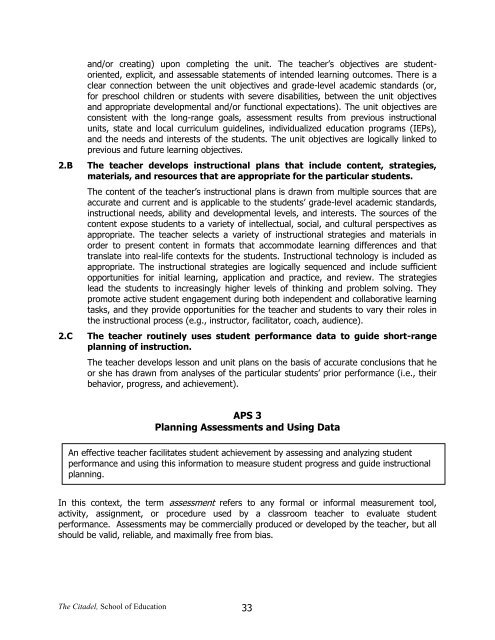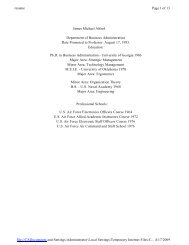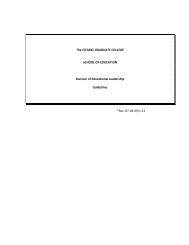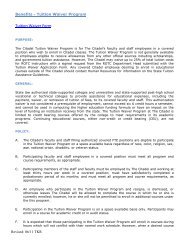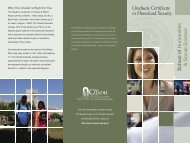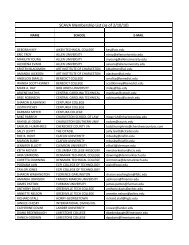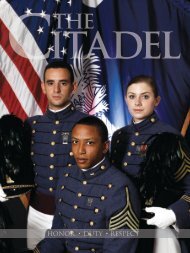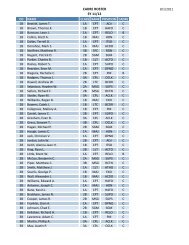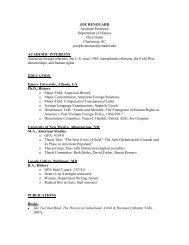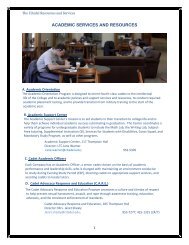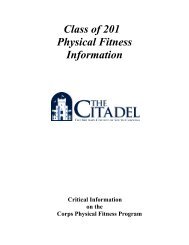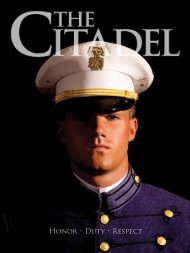Guidelines for Student Teaching Internship - The Citadel
Guidelines for Student Teaching Internship - The Citadel
Guidelines for Student Teaching Internship - The Citadel
You also want an ePaper? Increase the reach of your titles
YUMPU automatically turns print PDFs into web optimized ePapers that Google loves.
and/or creating) upon completing the unit. <strong>The</strong> teacher’s objectives are studentoriented,explicit, and assessable statements of intended learning outcomes. <strong>The</strong>re is aclear connection between the unit objectives and grade-level academic standards (or,<strong>for</strong> preschool children or students with severe disabilities, between the unit objectivesand appropriate developmental and/or functional expectations). <strong>The</strong> unit objectives areconsistent with the long-range goals, assessment results from previous instructionalunits, state and local curriculum guidelines, individualized education programs (IEPs),and the needs and interests of the students. <strong>The</strong> unit objectives are logically linked toprevious and future learning objectives.2.B <strong>The</strong> teacher develops instructional plans that include content, strategies,materials, and resources that are appropriate <strong>for</strong> the particular students.<strong>The</strong> content of the teacher’s instructional plans is drawn from multiple sources that areaccurate and current and is applicable to the students’ grade-level academic standards,instructional needs, ability and developmental levels, and interests. <strong>The</strong> sources of thecontent expose students to a variety of intellectual, social, and cultural perspectives asappropriate. <strong>The</strong> teacher selects a variety of instructional strategies and materials inorder to present content in <strong>for</strong>mats that accommodate learning differences and thattranslate into real-life contexts <strong>for</strong> the students. Instructional technology is included asappropriate. <strong>The</strong> instructional strategies are logically sequenced and include sufficientopportunities <strong>for</strong> initial learning, application and practice, and review. <strong>The</strong> strategieslead the students to increasingly higher levels of thinking and problem solving. <strong>The</strong>ypromote active student engagement during both independent and collaborative learningtasks, and they provide opportunities <strong>for</strong> the teacher and students to vary their roles inthe instructional process (e.g., instructor, facilitator, coach, audience).2.C <strong>The</strong> teacher routinely uses student per<strong>for</strong>mance data to guide short-rangeplanning of instruction.<strong>The</strong> teacher develops lesson and unit plans on the basis of accurate conclusions that heor she has drawn from analyses of the particular students’ prior per<strong>for</strong>mance (i.e., theirbehavior, progress, and achievement).APS 3Planning Assessments and Using DataAn effective teacher facilitates student achievement by assessing and analyzing studentper<strong>for</strong>mance and using this in<strong>for</strong>mation to measure student progress and guide instructionalplanning.In this context, the term assessment refers to any <strong>for</strong>mal or in<strong>for</strong>mal measurement tool,activity, assignment, or procedure used by a classroom teacher to evaluate studentper<strong>for</strong>mance. Assessments may be commercially produced or developed by the teacher, but allshould be valid, reliable, and maximally free from bias.<strong>The</strong> <strong>Citadel</strong>, School of Education 33


